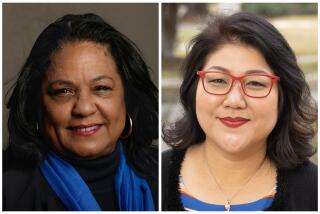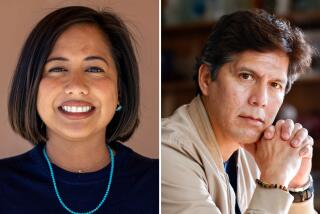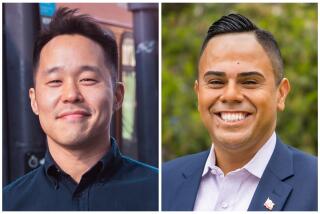Election Shaping Up as Referendum on Development Policies : Russell Put on the Defensive at 6th District Candidate’s Forum
- Share via
Speaking over a chorus of boos and cheers in a crowded Westchester church auditorium this week, Los Angeles City Councilwoman Pat Russell repeatedly denied accusations that she has become a pawn of developers and charged that her opponents in the 6th District race are waging a sleazy propaganda war.
“The big lie is a technique used by propaganda artists when hard choices must be made,” said Russell, speaking at the first major candidates’ forum. “Propagandists take power by urging the public to ignore the facts.”
The facts show that she has protected her district from overdevelopment, Russell said. But one fact that became clear at Tuesday’s forum, sponsored by the Coalition of Concerned Communities, is that the Westchester-Venice area election is shaping up as a referendum on Russell’s development policies.
The five challengers--Rimmon C. Fay, Ruth Galanter, Salvatore Grammatico, Virginia Taylor Hughes and Patrick McCartney--put Russell on the defensive by continually attacking her policies on growth. The theme played well in the Westchester area, where about 18 million square feet of development is planned.
‘Threatens Everyone’
“Runaway commercial development threatens the lives of everyone on the Westside,” said McCartney, a community activist from Venice who serves as president of the Coalition of Concerned Communities. “We need someone sensitive to our needs,” said Grammatico, a Mar Vista realtor. “We need a responsive council member who will listen,” added Galanter, a Venice planning consultant. “Someone who is not tied up with lobbyists and developers.”
Hughes, a Crenshaw businesswoman with an evangelical speaking style, pledged that she would be a strong advocate for residents. And Fay, a Venice marine biologist, said he would put an end to the “abuse of power” on the council.
The audience, which numbered several hundred people, submitted dozens of questions to the candidates, the majority focused on development. But there were also questions about contamination in Santa Monica Bay, the city budget, social services, police protection and Los Angeles International Airport.
Asked how they would produce more revenue to pay for services, Grammatico led off by saying that he would consider a tax on restaurants. Fay said the city should tax illegal workers. Hughes said her policy would be based on the needs of the district. McCartney said the city could consider a one-half cent sales tax increase or a tax on non-residents who work in Los Angeles.
Russell Issues Reminder
Russell reminded the audience that she had “pioneered” the law requiring that private developers help pay for public improvements. And Galanter said the City Council should take a hard look at ways to redistribute city funds.
The moderator also asked each candidate one specific question. Grammatico reiterated his support for additional business taxes to pay for public services. Fay said he backed restoration plans for the Venice canals. McCartney said that his opposition to major development did not mean he opposes the creation of jobs. He said that there should only be as much development and job growth as a community can handle. Hughes, queried on her knowledge of the Westchester area, said she had worked in the area and would open a campaign office there.
Galanter said she would try to control growth in Venice by encouraging community members to sit down and reach a consensus. She added that her planning background and community-advocate credentials qualified her for the job.
Russell was asked whether the initiative process was an effective way to address problems. “We need public input,” the councilwoman said. “And the initiative process is essential when people feel they have not been heard.”
Talks of Responsiveness
Russell returned to the topic of public responsiveness several times during the two-hour forum. The 30-year Westchester resident, who was first elected to the council in 1969 as an airport noise opponent and who now serves as council president, tried to calm anxiety over development by telling residents that she had successfully limited its impact.
The Playa Vista project, a planned community that will contain 10 million square feet of office space, homes and apartments, could have been three times larger, said Russell, adding that restrictions were also placed on the Howard Hughes Center, composed of 2.7 million square feet of offices and a 4-million-square-foot office development on the north side of the airport.
“We have more controls and more limits on development than anywhere else in Los Angeles,” Russell said.
The success of that argument will be put to the test during the next two months. Some political observers contend that Russell faces her toughest campaign ever because of anger of development. Others say that her opponents lack the funding and experience needed to mount a successful challenge.
The election is April 14.
More to Read
Sign up for Essential California
The most important California stories and recommendations in your inbox every morning.
You may occasionally receive promotional content from the Los Angeles Times.










